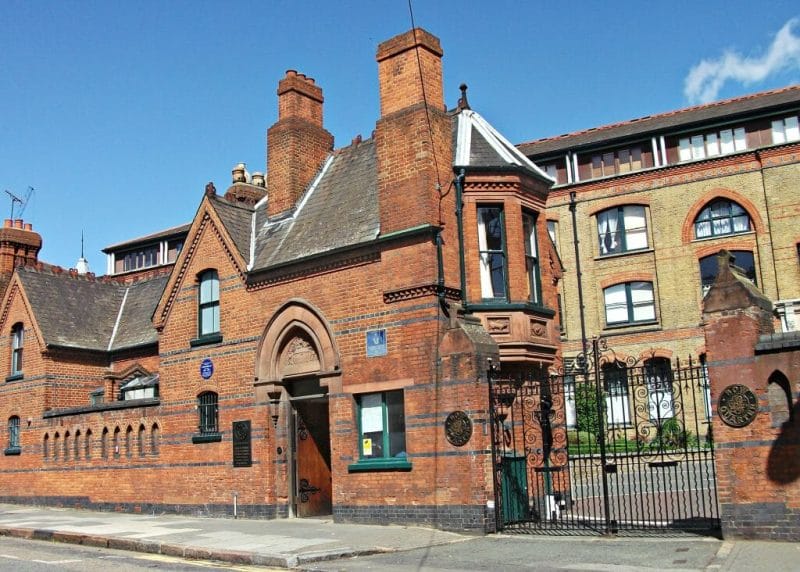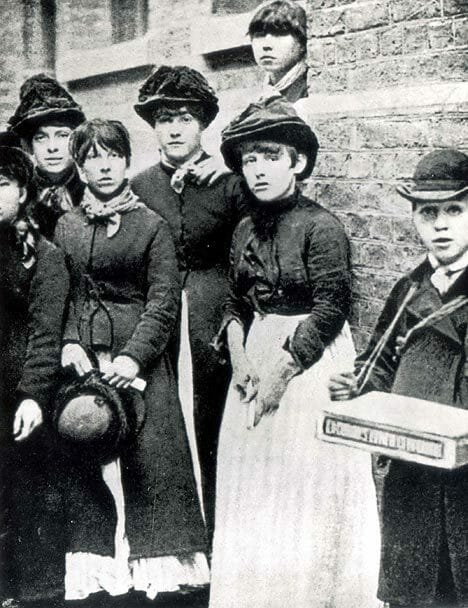During the 19th century, the match manufacturer, Bryant and May, was one of the leading employers in Bow in the East End of London. Although playing with matches is, as we all know, dangerous, at that time, just making matches could be deadly. Most people working in the factory were women, known as match girls.

It’s No Game
The Bryant and May Match Girls Strike
During its most busy period, the Bryant and May factory employed more than 2,000 girls and women. In 1888, horrible working conditions and the toxic materials used in manufacturing forced the match girls to go on one of the best-known strikes in London.
Why Did the Match Girls Go On Strike?
At this time, matches were made with white phosphorus; this substance formed the match head. This toxic material can seriously damage your health if you handle it or come into close contact with it regularly. But, it was the ideal substance for match manufacturers, as it was much cheaper than the safer alternative, red phosphorus.
Many match girls who worked with white phosphorus would develop a condition called “phossy jaw”. However, its medical name is phosphorus necrosis of the jaw. First, they would get severe toothaches, and their gums would swell.
Then, they would develop abscesses on their jaw bones. You could tell you had it because your bones would glow greeny-white in the dark. Over time, it could lead to brain damage, organ failure, and death. The only solution once you had a “phossy jaw” was surgically removing the infected jaw bones. This wasn’t much of a resolution at the time.
The match girls had more to worry about than “phossy jaw”, however. The working conditions in the Bryant and May factory were pretty bad; they worked fourteen hours a day for very little pay and were fined regularly for minor infractions, reducing their meagre income even more. Finally, the match girls cracked when one was dismissed in July 1888, and they went on strike.
The Life of a Match Girl
The match girls were mainly young women and girls from low-income families who lived in the overcrowded and unsanitary slums of London’s East End. They worked long hours, from 6:30 am to 6 pm, making matches from sticks of wood dipped in a mixture of chemicals, including white phosphorus. White phosphorus was a highly toxic substance that could cause severe burns, blindness, and even death if ingested or inhaled.

The match girls had to endure many hardships and dangers in their work. They had to stand all day without proper breaks. They were often fined for trivial offences such as talking, dropping matches, or having dirty feet. They had to pay for their tools and materials, such as brushes and paint, and even for the boys who helped them pack the matches into boxes. They earned meagre wages, about five shillings a week (equivalent to £25 today), barely covering their living expenses.
The most dreadful consequence of working with white phosphorus was a disease known as “phossy jaw”, which affected many match girls. Phossy jaw was a form of bone cancer that caused the jaw to decay and emit a foul-smelling discharge. The disease was excruciating and disfiguring and often fatal. The only treatment was to remove the affected part of the jaw, which left the victims mutilated and scarred for life.
The Match Girls Strike
It is thought that around 1,400 members of the workers decided to go on strike initially. This scared the factory managers, who immediately offered to give the sacked woman her job back. But, by this stage, the workers had had enough and started to ask for other things. For example, they demanded that management stop fining them. By July 6th 1888, the strike had spread across the factory, and nobody was working.
Social activists had been aware of conditions in the factory for a while, and the match girls now involved Annie Besant, who had already published a damning article on Bryant and May before the strike. Some newspapers and other social activists, such as George Bernard Shaw, started a strike fund to distribute emergency money to the striking workforce to keep them going.
This, combined with a lot of adverse publicity and a meeting between some workers and some MPs in parliament, started worrying factory managers. They agreed to meet with the workers to try to stop the strike with the help of Annie Besant.
Conditions at Bryant and May After the Strike
By July 16th 1888, management and workers had agreed on some core changes to working conditions. Management decided to do away with unfair fines and to allow workers to approach them with problems directly. Before, they had to talk to their supervisors, who often did not tell managers that there were any problems. From a medical perspective, the factory owners also agreed that workers could eat in a room separate from their workplaces so that their food would not become contaminated by white phosphorus.
Bryant and May also started a range of welfare initiatives on site, such as providing a dentist for workers. The factory would still, however, continue to use white phosphorus, and pay conditions generally did not improve.
The Spark of Rebellion
The match girls’ strike was triggered by an article published in The Link, a radical newspaper edited by Annie Besant, a social reformer and activist. The report exposed the appalling conditions at the Bryant and May factory. It accused the owners of exploiting and oppressing their workers. The article also called for a boycott of Bryant and May matches, branded as “Lucifers” or “Congreves”.
The article outraged the factory owners, who tried to force their workers to sign a statement denying the allegations and declaring their satisfaction with their work. When one of the workers refused to sign, she was sacked on the spot. This provoked a wave of anger and solidarity among her fellow workers, who decided to walk out of the factory in protest.
The strike soon gained public attention and support from various quarters, including trade unions, socialist groups, journalists, politicians, and celebrities. Besant played a crucial role in organizing and publicizing the strike and raising funds for the strikers’ relief. She also helped them form the Union of Women Match Makers, one of Britain’s first unions for unskilled women workers.
The key figures involved in the strike were:
- Annie Besant, a British socialist, theosophist, and women’s rights activist who wrote an article titled “White Slavery in London” about the poor working conditions at the Bryant and May match factory. This article played a significant role in sparking the strike.
- Kate Slater, Eliza Martin, and Jane Wakeling were among the leading matchgirls who organized the strike.
The Victory of the Match Girls
The strike lasted for 16 days, during which the match girls held daily meetings and demonstrations outside the factory gates. They also marched through the streets of London, chanting slogans such as “We’d rather starve quick than starve slow” and “No more white slave traffic for us”. They showed remarkable courage and determination in defying their employers and challenging the social norms that expected them to be docile and obedient.
The strike put immense pressure on Bryant and May, who faced a loss of production, a drop in sales, damage to their reputation, and a threat of legal action from Besant. They finally agreed to meet with a delegation of strikers and negotiate their demands. On July 16th 1888, they signed an agreement that granted most of the strikers’ requests, including:
- An end to fines and deductions
- A pay rise of 5%
- A reduction in working hours
- Improved ventilation and sanitation
- A recognition of the union
- A reinstatement of the sacked worker.
The match girls’ strike was a remarkable success that marked a turning point in the history of workers’ rights. It showed that even the most marginalized and exploited workers could stand up for themselves and win against powerful employers.
The Salvation Army and Red Phosphorus
Activists continued to lobby against using white phosphorus in match production. In the 1890s, the Salvation Army took direct action and started its match-making factory in the area. This factory used the safer red phosphorus and paid more fairly than others.
This added to the strain on Bryant and May, who continued to get a lot of negative publicity. By the early 1900s, the Bryant and May factory stopped using white phosphorus and switched to red. Ironically, the Salvation Army factory found it hard to profit, as red phosphorus made matches much more expensive. Bryant and May bought their factory in 1901. By 1908, the government banned the use of white phosphorus in match manufacturing.
Conclusion
The match girl’s strike of 1888 was a remarkable event that changed the course of history. It was a spontaneous and courageous act of resistance by a group of women and girls who refused to accept the inhumane and oppressive conditions they faced in their work. The strike improved their situation and inspired other workers to organize and demand their rights. The strike also raised public awareness and sympathy for the working class and their struggles. The match girl’s strike was a milestone in the history of workers’ rights and social justice in Britain.

Very interesting.
A seminal moment in working class and trade union history.Enacted in the then east London
borough of Poplar, as was the Poplar councillors rates rebellion.